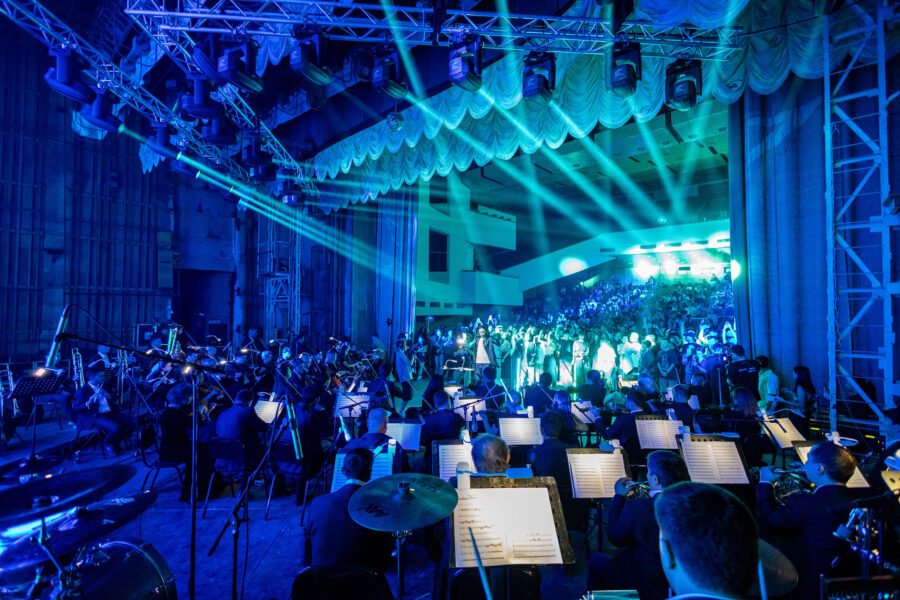It’s not everyday you get an invite to visit a country in Central Asia and witness a beautiful celebration of music and culture but last month, I travelled to Tashkent, Uzbekistan to attend the debut Sublimation Festival. Over the course of three days, Sublimation hosted a series of workshops, talks and a showcase of electronic music featuring mostly local artists. Held at the incredible Culture Palace of Aircraft Builders, which Sublimation carefully reconstructed with the help of Click and Iqos, it was like going back in time as the building had barely changed since the Soviet era and was a perfectly surreal setting for what took place in those walls over that weekend.
The programme included highly talked about sets from Ivan Dorn and Josef Tumari with the Symphony Orchestra and Setora alongside performances from Nazira, Qaraqoom, Konsta, Amalia, Sao, Bjarki, Matas Petrikas, Zengxrl, Samantha Togni and Less Feeling among others. Plus a Refuge Worldwide takeover featuring No Plastic, Milktea, Densk, Richard Akingbehin, and Arnav – listen back to the takeover here. In addition to this, there was an art exhibition curated by London-via-Uzbekistan artist Aziza Kadyri and a spotlight on Tashkent Modernism.
In Tashkent, there’s not really an infrastructure for electronic music to exist in as there’s no nightclubs or venues that are purposefully built for these sounds to be played in. It’s an emerging scene that’s very much on the rise, slowly but surely, with the help of Sublimation who are pushing for electronic music artists to be recognised in the country as well as being given opportunities to learn to play or produce. So at Sublimation Festival you could really feel and see on people’s faces that they were experiencing these sounds for the first time, especially in a clubbing environment. It was so pure and very special to witness, such a genuine excitement. And this really is down to the tirelessly work that the Sublimation collective are putting into creating these cultural moments and creating a scene for the next generation of artists to thrive in.
Founded in 2021 by two best friends, Sabina & Madina, Sublimation is a collective that aims to highlight the beauty of Uzbekistan and showcase the incredible talent and culture that often feels overlooked. Currently based in Tashkent and Riga, Sublimation’s members and affiliates currently include Josef Tumari, Doppi Twins, Ianiiiron and Xyarim, with co-founder Sabinē also often playing at their events. Last year, Sublimation hosted Boiler Room’s debut showcase in Uzbekistan after winning the platform’s Broadcast Lab grant initiative which helps bring a global attention to the incredible wealth of talent the collective have to offer.
With the festival feeling like a very exciting new chapter starting for the collective, we caught up with Sublimation post-event to talk about how the collective was founded, the decision behind hosting their first ever festival, approach to curation, their challenges, proudest moments and more.
Forever grateful to Sabina and Madina for inviting me to Sublimation Festival to partake in their conference and close the festival on Saturday night as well as being incredible hosts and showing us their beautiful country – I can’t wait to back!
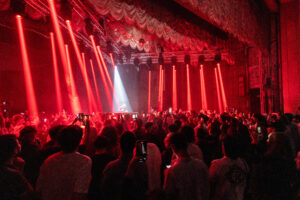
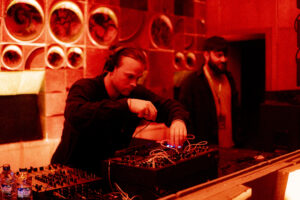
Let’s go back to the beginning—how did Sublimation come to life? What inspired you to create this event series and collective?
It all started with a friendship that has spanned years. Sabina and I have known each other since we were kids, and even back then, we loved bringing people together. It wasn’t just about socializing—it was about creating something larger than ourselves. When we were just 14, we organized our first event, not knowing that it would be the start of a much bigger journey. Over time, life pulled us in different directions, but we eventually reconnected with a shared goal: to highlight the beauty of Uzbekistan and showcase the incredible talent and culture that often feels overlooked.
Uzbekistan is such a unique place, but for some reason, it’s like a blind spot to the world. We both felt this deep responsibility to do something about that, to put a spotlight on the local artists, musicians, and creators whose voices deserve to be heard. That’s how Sublimation was born—not as just another event series, but as a collective effort to reintroduce the world to Uzbekistan through art and music. It’s more than a festival—it’s a mission to change perceptions and celebrate what we have.
What made you decide to host your very first festival in Tashkent?
Honestly, it was a mixture of practicality and love for the city. We both grew up here, and we know the potential of this place. Whenever we attended festivals abroad, we noticed that something magical happened after a couple of days—the energy, the sense of community, the collective euphoria. We wanted to recreate that, but in Tashkent. We thought, why not bring that magic home? The city has a rich history, and the people here have such open hearts—what better place to create an experience where people could connect through art and music?
One of our biggest goals was to make sure that everyone who came to the festival felt an instant sense of belonging. We didn’t want it to be just another concert or exhibition. We wanted to create a safe, inclusive space where people could feel part of something bigger than themselves. From the moment they stepped inside, we wanted them to know they were in the right place, surrounded by friends, even if they didn’t know anyone. That feeling of unity was at the core of everything we planned.
How did you approach the curation for the music and art programme?
We wanted to create an experience that felt intentional from the very first step. When you walked into the venue, we wanted the atmosphere to grab you right away, starting with something as simple as the building itself. Tashkent Modernism, which we highlighted on the first floor, became a kind of introduction to what you were about to experience—a blend of old and new, tradition and innovation. It was like a sneak peek into the festival’s identity.
One of my favorite features was the UzPost booth, where people could send postcards for free to anywhere in the world. It was such a small detail, but it created this beautiful moment of connection, allowing people to share a piece of their experience with someone far away. We had other spaces dedicated to different feelings—one room was a peaceful garden, a place to rest and reflect, while another showcased old Soviet-era televisions, offering a glimpse into different time periods. Everything had its place, and all the art and lighting installations were designed to enhance the beauty of the building without overpowering it. We wanted modernity and tradition to sit side by side, in harmony.
Putting on a festival is never easy. What were some of the biggest challenges you faced, and what were your proudest moments?
I think one of the biggest challenges was the venue itself. The Palace of Aviation Builders is an old building with so much history. We had to be really careful with renovations, balancing the need for modern infrastructure with preserving its historical beauty. It wasn’t easy, but it was worth it. Seeing the building come alive again was so rewarding, especially knowing how much it meant to the local community.
Working with government officials was another interesting experience. I wasn’t sure how it would go, but they were so supportive. Many of them shared personal memories of the building—it’s been a part of their lives for generations. Hearing those stories and knowing how much the space meant to people made us even more committed to getting everything right. The success of the festival wasn’t just about the event itself; it was about breathing new life into a place that had been quiet for too long.

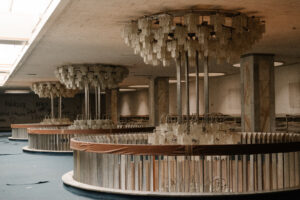
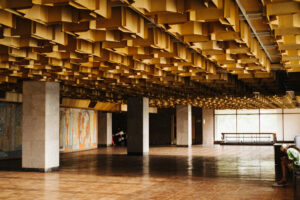
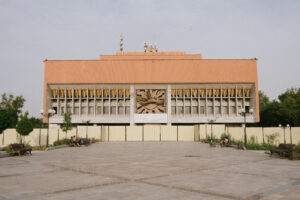
How do you see the local scene growing after the first festival? What needs to happen to keep the momentum going?
For the local scene to truly flourish, collaboration is key. We’re all working toward the same goal—promoting our culture and giving our artists a platform. But sometimes, we get caught up in competition. If we can shift our mindset toward collaboration, we’ll all benefit. That means working together, not just within Uzbekistan but across Central Asia. We have to lift each other up.
There’s also a lot to learn from each other. Every festival or event has its own strengths and weaknesses, and sharing those experiences can help us grow faster as a community. If we focus on working together, I truly believe the future of our scene will be brighter than we can imagine.
What does the current arts scene in Uzbekistan and Central Asia look like?
It’s a hidden gem, and I say that with so much pride. The talent here is massive. What’s interesting is that much of it has developed in a kind of isolation, which has led to some really authentic, unique styles. Now, there’s a hunger to share that with the world, and I think the rest of the world is starting to catch on.
There’s this vibrant diversity here—whether in music, visual arts, or dance. I feel like we’re at a tipping point. We’ve been in the shadows for too long, but now people are ready to shine. It’s exciting to think about what’s next because there’s just so much potential.
What do you hope the festival attendees took away from the experience?
Above all, I hope they felt safe. We live in a world where people are often hesitant to attend large gatherings, whether because of safety concerns or because they don’t feel like they belong. At Sublimation, I saw something different. People came with open hearts. They were curious, respectful, and ready to connect.
I had multiple people tell me, “This doesn’t feel like Uzbekistan. It feels like something you’d find somewhere else.” But the truth is, this is Uzbekistan. I want people to see that our country is capable of creating these kinds of experiences. There’s so much more here than what people often see. I hope the festival sparked a sense of pride in what’s possible and a curiosity for what’s next.
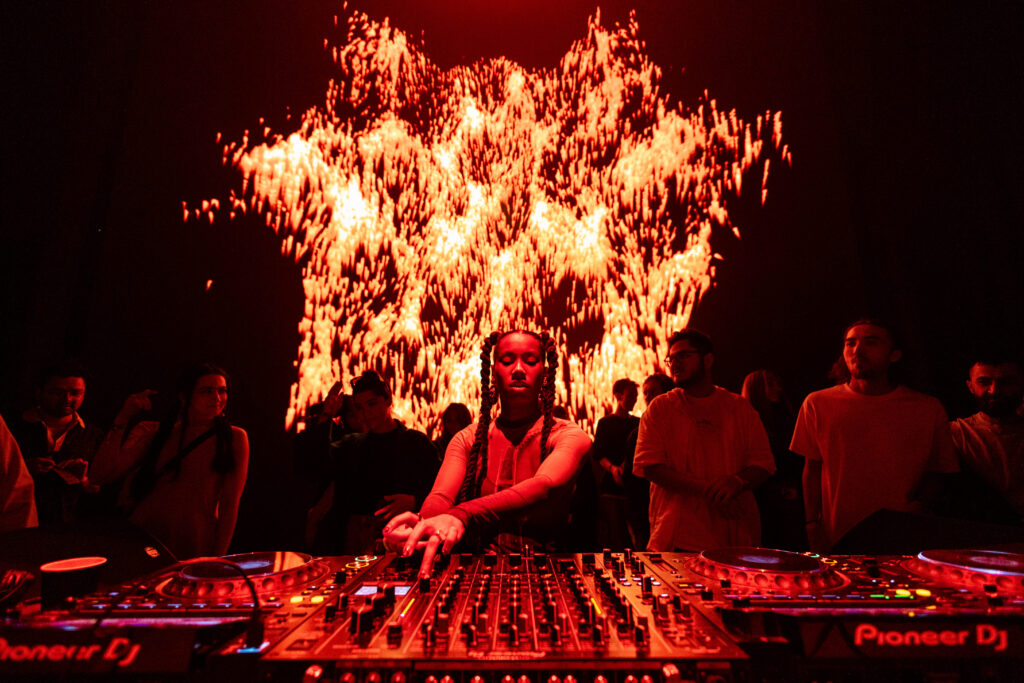
Were there any personal highlights for you during the festival? Moments that really stood out?
For me, it was all about the team. Seeing everyone work with so much heart was a highlight in itself. Mirshod Kamalov, our art director, and Diana Temirgalieva, our stage manager, along with the rest of the crew, treated this festival like it was their own personal project. No one watched the clock or complained about the long hours—they just gave everything they had. I think that’s why the festival felt so personal and intimate. We were all hosting it together, like a family welcoming people into our home.
Anything else you’d like to add or reflect on?
What excites me most is the future. We’re already thinking beyond just the next edition of the festival. We want to create something that lasts year-round—workshops, collaborations, partnerships with international artists. We want Sublimation to become a cultural hub, not just a festival. Uzbekistan has so much to offer, and we’ve only just started. What we’re doing goes beyond music or art—it’s about building a community, defining an identity, and creating a lasting impact on the cultural landscape of the region. I can’t wait to see where this journey takes us next.
Photo credits: Amir Melikov and Feruz Rustamov.
